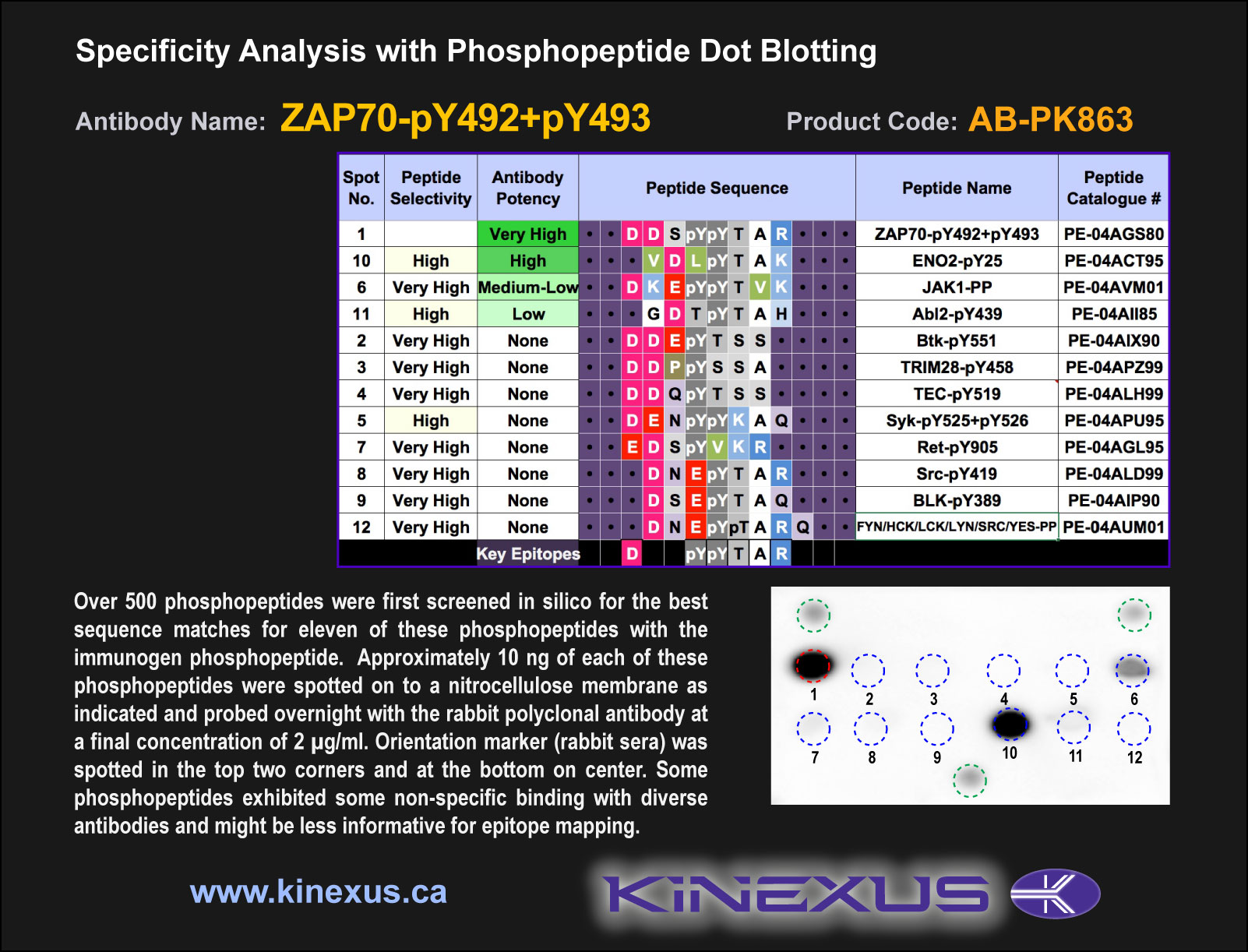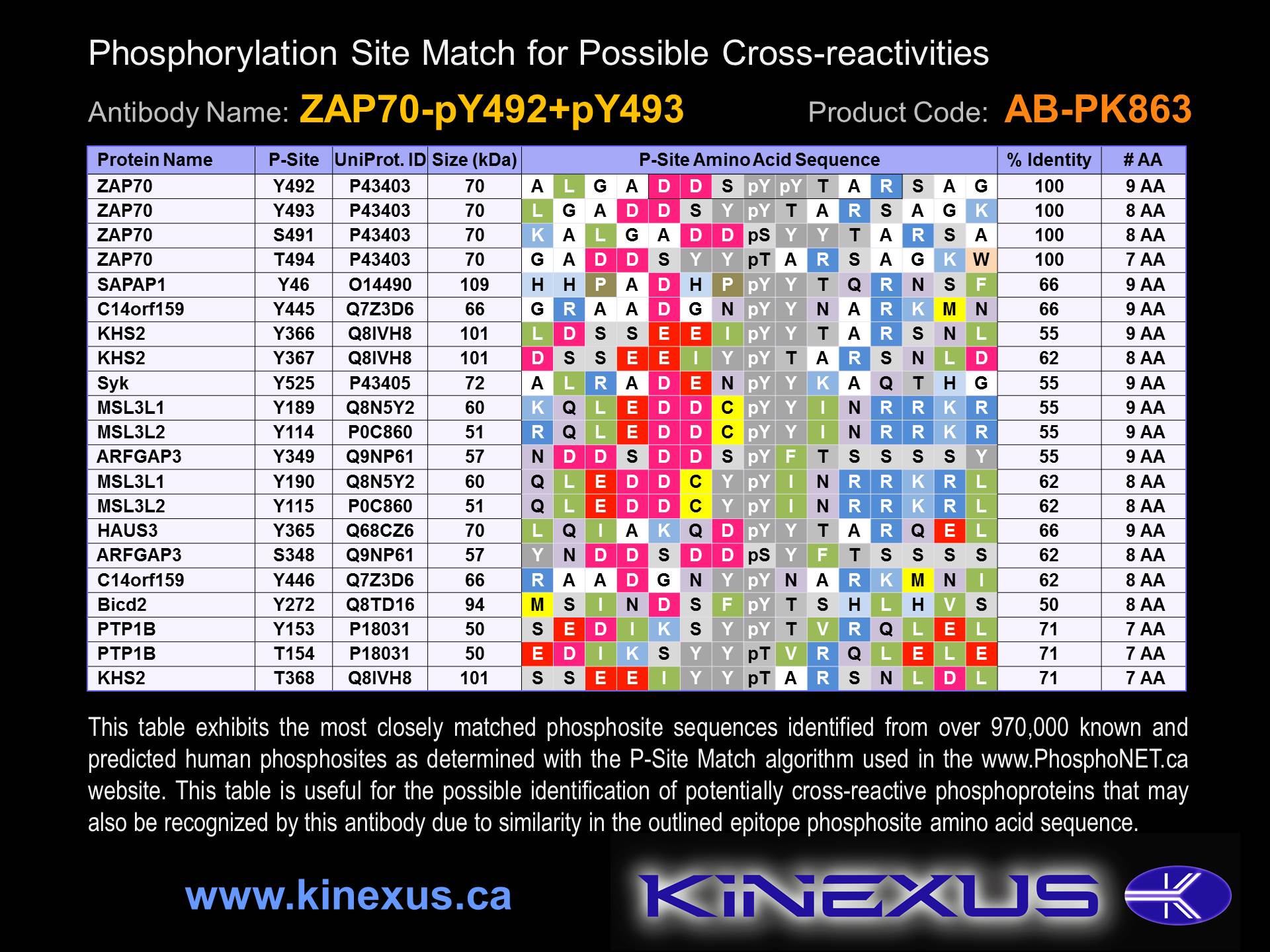Product Name: ZAP70-pY492+pY493
Product Number: AB-PK863
| Size: | 25 µg | Price: | 89.00 | |
| $US |
Target Full Name: Zeta-chain (TCR) associated protein-tyrosine kinase, 70 kDa
Target Alias: SRK; Syk-related tyrosine kinase; ZA70; ZAP-70
Product Type Specific: Protein kinase phosphosite-specific antibody
Antibody Code: PK863
Antibody Target Type: Phosphosite-specific
Antibody Phosphosite: Y492+Y493
Protein UniProt: P43403
Protein SigNET: P43403
Antibody Type: Polyclonal
Antibody Host Species: Rabbit
Antibody Immunogen Source: Human ZAP70 sequence peptide Cat. No.: PE-04AGS80
Target Alias: SRK; Syk-related tyrosine kinase; ZA70; ZAP-70
Product Type Specific: Protein kinase phosphosite-specific antibody
Antibody Code: PK863
Antibody Target Type: Phosphosite-specific
Antibody Phosphosite: Y492+Y493
Protein UniProt: P43403
Protein SigNET: P43403
Antibody Type: Polyclonal
Antibody Host Species: Rabbit
Antibody Immunogen Source: Human ZAP70 sequence peptide Cat. No.: PE-04AGS80
Antibody Immunogen Sequence: DDS(pY)(pY)TAR(bA)C
Antibody Immunogen Description: Corresponds to amino acid residues D489 to R496; In the protein kinase catalytic domain.
Antibody Immunogen Description: Corresponds to amino acid residues D489 to R496; In the protein kinase catalytic domain.
Production Method: The immunizing peptide was produced by solid phase synthesis on a multipep peptide synthesizer and purified by reverse-phase hplc chromatography. Purity was assessed by analytical hplc and the amino acid sequence confirmed by mass spectrometry analysis. This peptide was coupled to KLH prior to immunization into rabbits. New Zealand White rabbits were subcutaneously injected with KLH-coupled immunizing peptide every 4 weeks for 4 months. The sera from these animals was applied onto an agarose column to which the immunogen peptide was thio-linked. Antibody was eluted from the column with 0.1 M glycine, pH 2.5. Subsequently, the antibody solution was neutralized to pH 7.0 with saturated Tris.This antibody was also subject to negative purification over phosphotyrosine-agarose.
Antibody Modification: Unconjugated. Contact KInexus if you are interest in having the antibody biotinylated or coupled with fluorescent dyes.
Antibody Modification: Unconjugated. Contact KInexus if you are interest in having the antibody biotinylated or coupled with fluorescent dyes.
Antibody Concentration: 1 mg/ml
Storage Buffer: Phosphate buffered saline pH 7.4, 0.05% Thimerasol
Storage Conditions: For long term storage, keep frozen at -40°C or lower. Stock solution can be kept at +4°C for more than 3 months. Avoid repeated freeze-thaw cycles.
Product Use: Western blotting | Antibody microarray
Antibody Dilution Recommended: 2 µg/ml for immunoblotting
Antibody Potency: Weak immunoreactivity of a target-sized protein by Western blotting in HeLa and Jurkat cells treated with vanadate and phenylarsine oxide for 30 minutes.
Antibody Species Reactivity: Human
Storage Buffer: Phosphate buffered saline pH 7.4, 0.05% Thimerasol
Storage Conditions: For long term storage, keep frozen at -40°C or lower. Stock solution can be kept at +4°C for more than 3 months. Avoid repeated freeze-thaw cycles.
Product Use: Western blotting | Antibody microarray
Antibody Dilution Recommended: 2 µg/ml for immunoblotting
Antibody Potency: Weak immunoreactivity of a target-sized protein by Western blotting in HeLa and Jurkat cells treated with vanadate and phenylarsine oxide for 30 minutes.
Antibody Species Reactivity: Human
Antibody Positive Control: The observed molecular mass of the processed target protein on SDS-PAGE gels is reported to be around 65-75 kDa.
Antibody Specificity: High
Antibody Cross Reactivity: Almost no significant cross-reactivities detected in HeLa, Jurkat and MCF7 cells, except phenylarsine oxide (PAO) increases 70, 50 + 34 kDa cross-reactive proteins in Jurkat and HeLa cells.
Related Product 1: ZAP70-pY492+pY493 blocking peptide
Related Product 2: ZAP70-pY248 phosphosite-specific antibody (Cat. No.: AB-PK860)
Related Product 3: ZAP70-pY292 phosphosite-specific antibody (Cat. No.: AB-PK861)
Antibody Specificity: High
Antibody Cross Reactivity: Almost no significant cross-reactivities detected in HeLa, Jurkat and MCF7 cells, except phenylarsine oxide (PAO) increases 70, 50 + 34 kDa cross-reactive proteins in Jurkat and HeLa cells.
Related Product 1: ZAP70-pY492+pY493 blocking peptide
Related Product 2: ZAP70-pY248 phosphosite-specific antibody (Cat. No.: AB-PK860)
Related Product 3: ZAP70-pY292 phosphosite-specific antibody (Cat. No.: AB-PK861)
Scientific Background: ZAP70 (SRK) is a protein-tyrosine kinase of the TK group and Syk family. It is highly expressed in heart, lymph nodes, pancreas, parathyroid gland, spleen, stomach, thymus and tonsils. It plays an essential role in mediating the adaptive immune response. ZAP70 can control adhesion, motility, and cytokine production in T cells, and natural killer (NK) cell functions as well as the development of thymocytes and primary B-cells. ZAP70 is activated by phosphorylation at Y319, Y474 and Y493, and inhibited by phosphorylation at Y492, which functions as a docking site for Cbl. Phosphorylation of Y319 also increases PLC-g1+ and Ras activation, and it is an Lck binding site. Phosphorylation of Y315 of ZAP70 induces association with CrkII. Phosphorylation of S520 primes ZAP70 binding to the plasma membrane. ZAP70 mediates T-cell antigen receptor (TCR) signalling. ZAP70 is phosphorylated and activated by the doubly-phosphorylated TCR component CD247/CD3Z at the plasma membrane. Ligation of the TCR/CD3 receptor in Jurkat T-cells induces complexes which contain ZAP70. TCR zeta chains are initially phosphorylated by Lck, which leads to the recruitment of ZAP70 via its SH2 domain. ZAP70 in turn phosphorylates the zeta-chain dimer in the TCR/CD3-phosphoprotein complex. ZAP70 may be an oncoprotein (OP). Gain-of-function mutations in the ZAP70 gene have been observed in several human cancer types, including neck squamous cell carcinomas, Malt lymphomas, acute lymphoblastic leukemias (ALL) and in chronic lymphocytic leukemias (CLL). ZAP70 has also been linked with severe combined immunodeficiency, chronic arthritis, and selective T-cell defects.
Figure 1. Epitope mapping of ZAP70-pY492+pY493 antibody with similar phosphopeptides on dot blots.
Figure 2. Identification of phosphosites related to ZAP70-pY492+pY493.
© Kinexus Bioinformatics Corporation 2017



